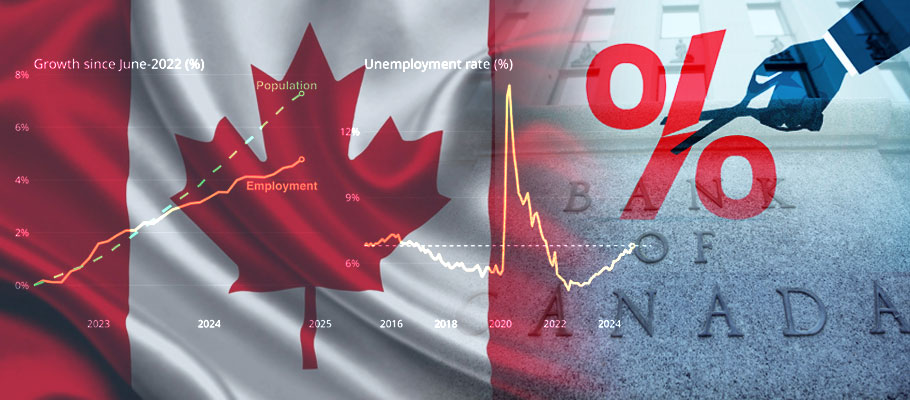
Published: June 11th, 2025
Higher-than-expected Canadian jobs data appears to justify the Bank of Canada's recent decision to keep interest rates unchanged. Analysts believe the Bank is likely to make just one more cut in the current cycle, supporting Canadian bond yields and taking pressure off the Loonie.
In a weekly forex research note, economists at Goldman Sachs removed a cut from their policy forecasts and now believe the BoC will make one last reduction this year, bringing the terminal rate down to 2.5 per cent.
‘Even though Canada's most recent labour market print was tepid and ongoing rises in the unemployment rate suggest diminishing growth, the softening economic picture isn't negative enough yet to compel BoC policymakers to speed-up the pace of cuts.’
Goldman notes that the BoC still has to balance the complex tradeoffs between inflation and growth risks.
‘A more hawkish policy footing from the BoC, paired with stronger growth later in 2025, should lend support to CAD.’
USD/CAD has sunk lower since the Wall Street investment giant last updated its forecasts, which indicated improving Loonie appreciation in late-April. The bank's analysts said the pace of appreciation would likely be sustained, ‘reiterating our upbeat view on the currency.’.
CAD faces potential headwinds from escalating trade tensions between the US and China. Language coming out of this week's meetings in London, however, suggest tensions may be receding as progress on various sticking points could unlock last month's provisional trade accord in Geneva.
In mid-May, forex strategists at Morgan Stanley said the global investment bank had turned ‘CAD seller’ given a backdrop of global trade uncertainty.
‘The challenging global trade environment paired with downside growth risks from below the border bodes poorly for the Canadian Dollar,’ Morgan analysts wrote. ‘A US slowdown would have negative spillovers for the Canadian economy, exposing it in ways that other G10 economies won't experience.’
Tightly interlinked trade between the two countries becomes a risk rather than benefit in this scenario, according to Morgan Stanley. While American economic prints continue to point to robust growth in the face of elevated trade uncertainty, Morgan economists believe signs of a slowing economic pulse will soon appear.
Canada's economy depends on US imports and supply chains. Were trade relations between the two countries to sour further under Trump, any slowdown south of the border could weigh heavily on Canadian domestic growth prospects.
The potential for additional weakness in Canadian output will have central bankers in Ottawa watching for signals to cut interest rates again, which could undermine the Loonie's interest rate support.
‘Recent comment from the Bank of Canada (BoC) points to some members of the Governing Council favouring a cut at the next meeting rather than holding course,’ notes Morgan Stanley.
The BoC's last meeting summary in April suggested policy setters were watching for weakening business and consumer confidence data.
A February 2025 note to investors from Deutsche Bank predicted that the Canadian Dollar could test new all-time lows this year if the new Trump administration levied its proposed 25 percent import tariff on Canadian goods.
The pre-inauguration threat made by Trump via X and his own Truth Social network sent the Loonie hurtling Earthward. Canadian officials have responded angrily, with then Prime Minister Justin Trudeau saying that Canada would respond ‘dollar for dollar’ with retaliatory tariffs of its own.
Deutsche analysts wrote that the very real prospect of an escalating US-Canada trade war would be a ‘worst-case scenario’ for Canada's domestic economy and CAD.
‘Should American tariffs go ahead, it's natural to assume Ottawa will fight back with tariffs of its own, and in product categories similar to those targeted in the previous 2018 Trump tariff battle. What's different today is that the Canadian government has also mooted the idea of export taxes on commodities. In a trade battle with the US this could give Canada real leverage, despite its much smaller economy.’
Deutsche analysts believed the impact on Canadian aggregate demand would be ‘significant, probably damaging enough to push Canada into a recession.’
In that scenario the Bank of Canada would have to respond strongly, forcing central bank policymakers to cut rates more deeply and for longer than previously expected. The result could be a weakened Loonie.
Trump was and remains keen to make good on his threat. He repeatedly singled out Canada and Mexico on the campaign trail as priority targets for new tariffs. He argued that lax border enforcement by both countries has exacerbated illegal immigration to the US.
Canadian households and businesses will continue to tolerate a period of uncertainty, which could create headwinds that dampen economic growth.
In early February, USD/CAD was trading at about 1.4330, continuing an earlier advance prompted by the White House sharply raising import duties on aluminium and steel to 25%, but without modifications or exemptions.
The pair gained value due to trade tensions. The action increases the possibility of a multifront trade dispute while attempting to assist faltering domestic businesses.
In addition to removing quota agreements, national exemptions, and hundreds of thousands of specific-to-product tariff exemptions for both metals, Trump issued proclamations that increased the nation's aluminium tariff percentage from 10% to 25%.
In 2024, almost 80% of the US's principal aluminium imports were from Canada. About 23% of the steel consumed in the United States in 2023 came from imports, with Mexico, Brazil, and Canada being the main suppliers.
The United States Dollar Index (DXY), which compares the value of the US dollar to six major currencies, has continued to advance for the fourth straight session and is currently trading close to 108.50.
January jobs data showed a decrease in unemployment but slower job creation in the US, the Federal Reserve of the United States was expected to maintain interest rates at their current level this year, which supports the greenback.